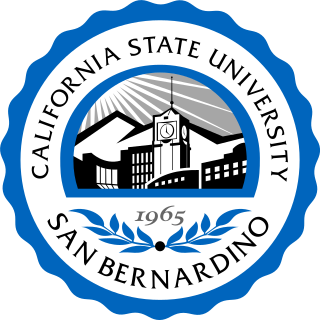Related Research Articles

The SAT is a standardized test widely used for college admissions in the United States. Since its debut in 1926, its name and scoring have changed several times; originally called the Scholastic Aptitude Test, it was later called the Scholastic Assessment Test, then the SAT I: Reasoning Test, then the SAT Reasoning Test, then simply the SAT.

A law school in the United States is an educational institution where students obtain a professional education in law after first obtaining an undergraduate degree.

California State University, San Bernardino is a public research university in San Bernardino, California. Founded in 1965, it is one of the 23 general campuses of the California State University system. The main campus sits on 441 acres (178 ha) in the University District of San Bernardino, with a branch campus of 40 acres (16 ha) in Palm Desert, California, opened in 1986. Cal State San Bernardino's fall 2020 enrollment was 19,404. In fall 2018, it had 310 full-time faculty, of which 220 were on the tenure track.
Grading in education is the process of applying standardized measurements for varying levels of achievements in a course. Grades can be assigned as letters, as a range, as a percentage, or as a number out of a possible total.

The British undergraduate degree classification system is a grading structure for undergraduate degrees or bachelor's degrees and integrated master's degrees in the United Kingdom. The system has been applied in other countries and regions.
Latin honors are a system of Latin phrases used in some colleges and universities to indicate the level of distinction with which an academic degree has been earned. The system is primarily used in the United States. It is also used in some Southeastern Asian countries with European colonial history, such as Indonesia and the Philippines, although sometimes translations of these phrases are used instead of the Latin originals. The honors distinction should not be confused with the honors degrees offered in some countries, or with honorary degrees.
Valedictorian is an academic title of success used in the United States, Canada, Kuwait, Egypt, Philippines for the student who delivers the closing or farewell statement at a graduation ceremony. The chosen valedictorian is traditionally the student with the highest academic standing among their graduating class, and that standing is commonly determined by a numerical formula for Grade Point Average (GPA), but other methods of selection are also in use. The term is an Anglicised derivation of the Latin vale dicere, historically rooted in the valedictorian's traditional role as the final speaker at the graduation ceremony before the students receive their diplomas. The valedictory address generally is considered a final farewell to classmates, before they disperse to pursue their individual paths after graduating.
Texas House Bill 588, commonly referred to as the "Top 10% Rule", is a Texas law passed in 1997. It was signed into law by then governor George W. Bush on May 20, 1997.
University admission or college admission is the process through which students enter tertiary education at universities and colleges. Systems vary widely from country to country, and sometimes from institution to institution.
A dean's list is an academic award, or distinction, used to recognize the highest level scholarship demonstrated by students in a college or university. This system is most often used in North America, though institutions in Europe, Asia, and Australia may also employ similar measures. It is often synonymous with honor roll and honor list, but should not be confused with honours degrees.

Hornstine v. Moorestown, 263 F. Supp. 2d 887, was a 2003 case in the United States District Court for the District of New Jersey that considered whether grades received by a student with a disability for classes where accommodations had been made under an Individualized Education Program could be discounted in awarding valedictorian honors. Blair Hornstine, then in her final year at Moorestown High School, sued the Moorestown Township Public Schools Board of Education to stop them "from retroactively applying to her a proposed policy amendment that would allow the designation of multiple valedictorians". Under the then existing school policy, Hornstine would have been the sole recipient of the honor.
College admissions in the United States refers to the process of applying for entrance to institutions of higher education for undergraduate study at one of the nation's colleges or universities. For those who intend to attend college immediately after high school, the college search usually begins in the eleventh grade with most activity taking place during the twelfth grade, although students at top high schools often begin the process during their tenth grade or earlier. In addition, there are considerable numbers of students who transfer from one college to another, as well as adults older than high school age who apply to college.

NSITE High School is a business and technology magnet high school part of the Northside Independent School District in San Antonio, Texas. It is a "school within a school" located on the campus of Oliver Wendell Holmes High School. The school attracts students who want to study business and other related fields. The school allows the students to grasp the concepts of the business world easier by offering laptops to each student to use for a school purposes.
Grade inflation is the awarding of higher grades than students deserve, which yields a higher average grade given to students.
Silva Magnet High School is a health-focused magnet high school within the El Paso Independent School District in El Paso, Texas.

Education in Georgia consists of public and private schools in Georgia, including the University System of Georgia, Technical College System of Georgia, private colleges, and secondary and primary schools.

Transfer admissions in the United States refers to college students changing universities during their college years. While estimates of transfer activity vary considerably, the consensus view is that it is substantial and increasing, although media coverage of student transfers is generally less than coverage of the high school to college transition. A common transfer path is students moving from two-year community colleges to four-year institutions, although there is also considerable movement between four-year institutions. Reasons for transferring include unhappiness with campus life, cost, and course and degree selection. There are no standardized rules nationwide for transfers, and requirements vary by college. However, many states have taken steps to make the transition easier and less problematic, particularly from community colleges to four-year schools within the state, by various methods including school-to-school credit arrangements called articulation agreements. While many state universities are constrained by budget cuts which have sometimes lessened the number of spots open to transfer students, there are reports that many private colleges are becoming more assertive in seeking transfer applicants. Nevertheless, the transfer process can be difficult, such that transfer applicants have been described as collegiate "academic nomads" who face various obstacles trying to make sure their credits transfer properly to their new school. Unlike admission from high school directly to college, there is less data nationwide about transfer admissions, although there are signs that this is changing.

Mahidol University International College is Thailand's first public international college. It is part of Mahidol University and is located on the university's Salaya Campus in Nakhon Pathom Province.
Higher education in the United States is an optional stage of formal learning following secondary education. Higher education, also referred to as post-secondary education, third-stage, third-level, or tertiary education occurs most commonly at one of the 4,360 Title IV degree-granting institutions, either colleges or universities in the country. These may be public universities, private universities, liberal arts colleges, community colleges, or for-profit colleges. US higher education is loosely regulated by several third-party organizations.
References
- 1 2 3 "Counselor's Connection - Apply to College: Class Rank and College Admissions". The College Board. Archived from the original on July 10, 2007. Retrieved July 5, 2007.
- ↑ Finder, Alex (March 5, 2003). "Schools Avoid Class Ranking, Vexing Colleges". The New York Times . Retrieved July 5, 2007.
- ↑ "California residents | UC Admissions".
- ↑ Lang, David M. (April 1, 2007). "Class Rank, GPA, and Valedictorians: How High Schools Rank Students". American Secondary Education. 35 (2): 36–48. ISSN 0003-1003.
- ↑ "The University of Texas at Austin to Automatically Admit Top 10 Percent of High School Graduates for 2011" . Retrieved 2010-04-05.[ permanent dead link ]